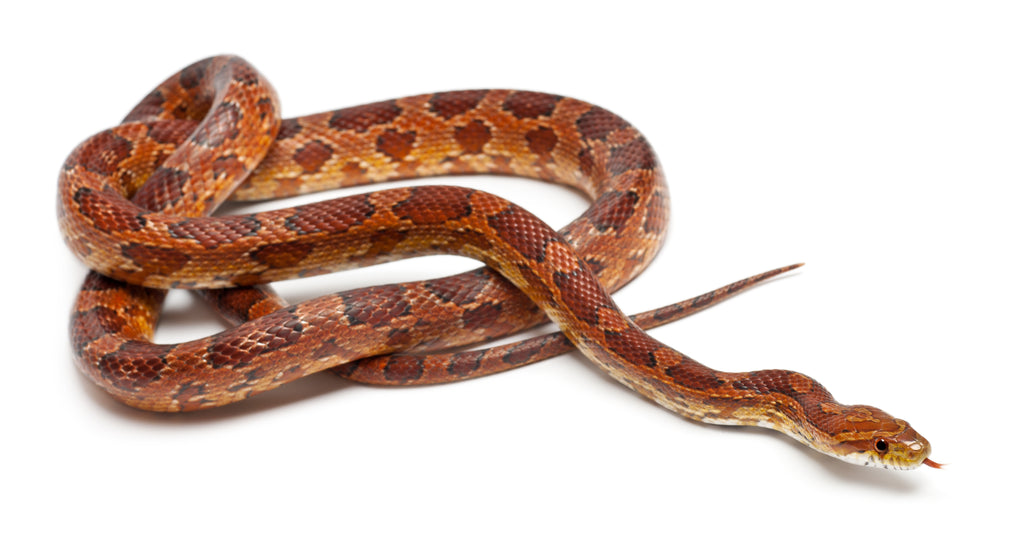Corn Snake (Pantherophis guttatus) care sheet

Corn Snake (Pantherophis guttatus)
This article is brought to you by Mariah Healey creator of ReptiFiles.com
Difficulty: Easy
Corn snakes are nonvenomous, terrestrial snakes native to the southeastern United States, parts of Mexico, and the Cayman Islands. They got their name from early European settlers who found these snakes in their corn fields and corn cribs, and concluded that the snakes must be feasting on the corn. The snakes were not, in fact, eating the corn — they were eating the rodents which were eating the corn.
Corn snakes are crepuscular, which means that although they are active at night, they are most active around dawn and dusk. They spend most of their waking hours looking for prey.
Corn snakes grow to 3-5’ long as adults, and males tend to be smaller than females. In captivity they generally live for about 15-20 years.
Corn snakes are popular snakes for first-timers and more experienced reptile keepers alike due to their simple care requirements, active and curious personalities, and exceptional hardiness.
Shopping List
- 4' x 2' x 2' enclosure, minimum
- Zoo Med Basking Spot Lamp, 100 Watt
- Exo Terra Reptile Glow Light Clamp Lamp, Medium
- plug-in lamp dimmer
- Bio Dude Digital Thermometer / Hygrometer
- temperature gun
- Arcadia Forest D3 6% UVB T5 Bulb 34"
- The Bio Dude Solar Grow T5 HO Single Bulb Light Strip 36"
- Zilla 24/7 Digital Timer Power Center
- Terra Firma Bioactive Kit 4' x 2' x 2
- 2+ hides/caves
- decorations: branches, plants, cork logs, rocks, etc.
- large water bowl
- 12” soft-tipped feeding tweezers
Terrarium Size
The general rule for determining minimum enclosure size for a primarily terrestrial snake goes like this:
- length = snake length
- width = half snake length
- height = half snake length
Considering that corn snakes average between 3-5′ long as adults, the minimum corn snake enclosure size is going to be at least 120 gallons, or 48″x24″x24″. Of course, bigger is always going to be better.
Front-opening terrariums work well for housing snakes, especially corn snakes, because they tend to be more difficult to escape from. Front-opening terrariums also tend to hold heat and humidity better and make access easier.
Some advise housing young corn snakes in small enclosures until their reach adulthood. However, as long as your corn snake is not very young (read: near hatchling size), and they have plenty of places to hide, they should be able to live in an adult-sized enclosure without issue.
Corn snakes are not social animals, and so multiple snakes should not be kept in the same enclosure.
Lighting, Temps & Humidity
Lighting
Corn snakes are most active at night, particularly around dawn and dusk. Having a light in their enclosure helps them regulate their day/night rhythm, and is more effective than simply relying on light coming through a window or from a light in the room.
There is a common belief that snakes don’t “need” UVB to survive, and for that reason, shouldn’t have access to it because it will “stress them out” or “hurt their eyes.” But there is no real evidence that, when used properly, UVB actually harms corn snakes.
There is mounting scientific evidence, however, that UVB can be beneficial for snakes, and many experts recommend using it as part of providing optimum care. For a corn snake housed in a 75 gallon enclosure, we recommend using a 22” Zoo Med T5 HO ReptiSun 5.0 or Arcadia Forest 6%, mounted on the same side of the enclosure as the heat lamp.
Any lights in a corn snake enclosure should be left on for about 12 hours/day. Colored bulbs are unnecessary and can even be harmful, so they should not be used.
Heat
Corn snakes are ectotherms (cold-blooded). This means that they rely on the heat in their environment to regulate their body temperature. So as pets, corn snakes need a range of temperatures in their enclosure that allow them to regulate their body temperature as needed. This is the optimal temperature gradient for corn snakes:
- Basking surface: 90-95°F
- Cool side: 75-80°F
The best way to provide heat for your pet corn snake is with a halogen heat lamp, as this is the closest way to replicate the warming effect of the sun in nature. These are also much more effective for bioactive enclosures than heat mats.
Use a white or clear halogen flood bulb like the Zoo Med Repti Basking Spot 100w or Philips 90w PAR38 Halogen Flood Bulb housed in a dimmable dome lamp for best results. If your dome lamp does not have a built-in dimmer, it’s a good idea to plug your lamp into a lamp dimmer so you can turn down the lamp if it gets too hot.
Place the lamp on the extreme left or right side of the enclosure to create a healthy temperature gradient. To measure your temperature gradient, use a temp gun like the Zoo Med ReptiTemp or Etekcity 774.
Humidity
Corn snakes do best with average humidity levels of 40-50%. Correct humidity levels help maintain good skin, scale, and respiratory health, and help prevent dehydration.
Bioactive setups are very good at maintaining humidity, but if you need to raise the humidity levels, mist the enclosure with a spray bottle and some distilled water.
To keep track of your humidity levels, use a hygrometer like the Zoo Med Digital Thermometer and Humidity Gauge. Place the humidity probe on the cool side of the enclosure to get a good sense of your humidity gradient.
Substrate
To create a bioactive corn snake vivarium, you will need a bioactive-compatible substrate. That means that things like coconut husk or cypress mulch aren’t going to work. You need a soil-like mix that mimics the conditions of your corn snake’s natural habitat. You can make your own with 2 parts organic topsoil, 2 parts Zoo Med Reptisoil (or similar), and 1 part play sand, or you can let The Bio Dude do the work for you with a Terra Firma Bioactive Kit for 120 gallon enclosures.
Because you’re setting up a bioactive habitat, you will need to mix and layer the substrate with sphagnum moss and leaf litter. For best results, combine with an appropriate amount of Bio Dude Bio Shot reptile-safe fertilizer.
Decorating the Enclosure
Enclosure décor is more than just making your setup look good. It’s also an important part of providing environmental enrichment to your corn snake, which enhances your pet’s quality of life by providing opportunities to express natural behaviors, explore, and exercise. And since corn snakes like to hide and climb, feel free to clutter it up!
Here are some ideas for ways that you can decorate and enrich your corn snake’s bioactive vivarium:
- hollow cork logs
- branches
- hides/caves
- plants
- décor
Feeding Your Corn Snake
Corn snakes, like other snakes, are carnivores. This means that they need to eat whole animals in order to get the nutrition that they need to be healthy.
Here is a rough chart of how much and how often you should be feeding your pet corn snake:
- Hatchling to 2 months —1 pinkie mouse
- 4 months — 2 pinkie mice
- 6 months — 3 pinkie mice
- 8 months — 1 fuzzy mouse
- 10 months — 2 fuzzy mice
- 12 months — 3 fuzzy mice
- 14 months — 1 small mouse
- 16 months — 2 small mice
- 18 months — 1 or 2 adult mice
Young corn snakes should be fed once every 7-14 days. Adults (18+ months old) should be fed once every 14-21 days.
The above chart is based on age, but not all corn snakes grow at the same rate. If you have a young corn snake and can’t get information from the pet store or breeder about its age, choose a prey item that is only a little larger than the snake is at its widest point. Then offer it feeders until it refuses, and repeat 7-14 days later.
Weighing your snake regularly with a kitchen scale can be a good way to make sure it’s getting enough to eat. If it starts to lose weight, feed more often. If it’s an adult and is rapidly gaining weight, feed less often.
Water
Keep a large, shallow bowl of fresh water in the enclosure at all times. The water should be changed at least twice weekly or whenever it gets soiled. Scrub the bowl with an animal-safe disinfectant before replacing.
Handling Tips
After bringing your new pet home, do not handle it until it is eating regularly. This can take anywhere from two weeks to two months, so be patient and use this time to make sure your husbandry is on point. Once your snake is ready for handling, handle it at least 1-2x weekly to keep it accustomed to you, but no more than once daily.
Wash Your Hands First
Before you pick up your corn snake, first wash your hands with soap or hand sanitizer. This removes potentially harmful bacteria, viruses, or parasites from your hands, as well as makes your hands smell distinctly inedible. Corn snakes find prey via heat and smell. If your (warm) hands smell like rat, animal, or anything else remotely appetizing, your pet may confuse you for food.
How to Pick Up a Snake
Next, use a paper towel roll to tap its head (gently). This sets expectations by letting the snake know that it’s time for handling, not food. Pick it up with two hands, one behind the head and one supporting the rest of the body. NEVER pick up a snake by its tail — this can really hurt their spine!
Safety with Snakes
Always supervise children closely when they are handling a pet snake (or any kind of pet, frankly). This is as much for the snake’s safety as it is for the child’s. Keep the snake’s head away from your face, and don’t let it wrap around your neck.
DO NOT Handle If…
Don’t handle your snake within 48 hours of a meal, as this can stress them out and lead to regurgitation, which is a traumatic experience that can actually lead to death.
Also do not handle if your pet’s eyes have turned opaque or cloudy. This means that the snake is preparing to shed and can’t see well, making them more jumpy than usual and more likely to bite out of self-defense.
Care information courtesy of ReptiFiles. Visit ReptiFiles.com for further information on corn snake care.
- Josh Halter








